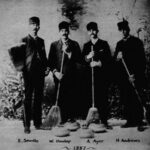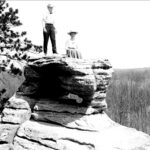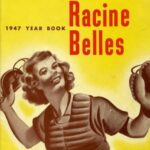A stone slides across the ice as millions of people hold their breath. Furiously, two men sweep their brooms across the ice, attempting guide the hurdling block of granite to its destination. The stone slows to a crawl, hovering across the slick surface as it settles in the middle of a target painted on the ice. Bullseye! The crowd exclaims as the scoreboard lights up, gifting the winning points to the athletes responsible for this feat. This is curling, a sport also known as “the roaring game” for the sound made as the heavy granite stone rumbles across the ice.
Curling equipment (such as the granite stone) was not always regulated to ensure an even playing field. While today standardized granite stones are made from rock quarried exclusively from the island of Ailsa Craig in Scotland, historically these stones were not easily accessible, which forced curlers to make their own stones out of local materials as exemplified by this wooden curling “stone”. When curling was brought to the United States by Scottish and English immigrants (curling originated in Scotland in the 16th century), it quickly found a home in the hearts of the people of the Upper Midwest. The icy terrain and frozen lakes and rivers made Wisconsin a perfect place for the game to develop and grow.

Because Wisconsinites could seldom afford to import their own regulation stones from across the Atlantic, they used what they had, like local wood and iron imported from the Lake Superior ranges. These two resources come together to create curling stones much like the one here: an iron handle offers grip for the player, and the rounded form could be easily fashioned from the already circular trunk of a tree. This Wisconsin craftmanship allowed players to improve their curling game for half a century before more reliable rock/granite stones became commonplace and the wooden stone began to fade into obsolescence. Yet years later, the wooden curling stone can offer a view into what life was like for Wisconsinites as they formed their own culture and helped curling evolve into the Olympic sport that it has become today.

This particular wooden stone hails from Lodi, Wisconsin, a small town just northwest of the state’s capital. Found sunken in Lodi’s Spring Creek, it has been dated to the mid-nineteenth century, a time when curling was still in its youth globally. While the sport continued to grow not only throughout Wisconsin but the entire world, it is safe to assume that the stone was used by Lodi’s citizens in a recreational way, likely on the very creek in which it was found when this small body of water froze in the wintertime. Even though the stone was recovered from the creek bed, the stones condition also suggests that it was heavily utilized, offering further proof of the connection between Wisconsinites and curling.
Use of wooden stones like this would end in the 1890s as overseas transportation became more commonplace, which allowed Wisconsinites to import more reliably gliding rock stones. As a result, wooden stones such as this fell out of use, and this one was left to be forgotten under the water of Spring Creek. Since its recovery after nearly a century underwater it serves to provide a window into Wisconsin’s past.
Written by John Tarlizzo, May 2024.
Sources
Wisconsin Historical Society. “Wooden Curling Stone,” April 23, 2013. https://www.wisconsinhistory.org/Records/Article/CS2753.
World Curling Federation. “History of Curling.” Accessed November 29, 2023. https://worldcurling.org/about/history/.




